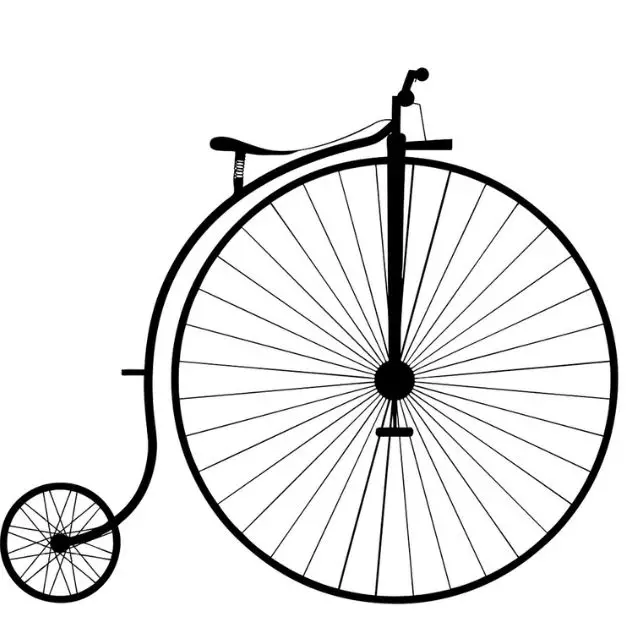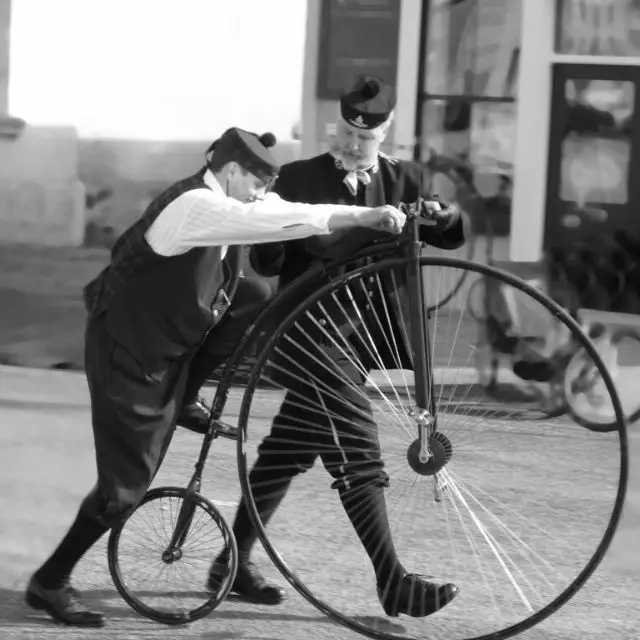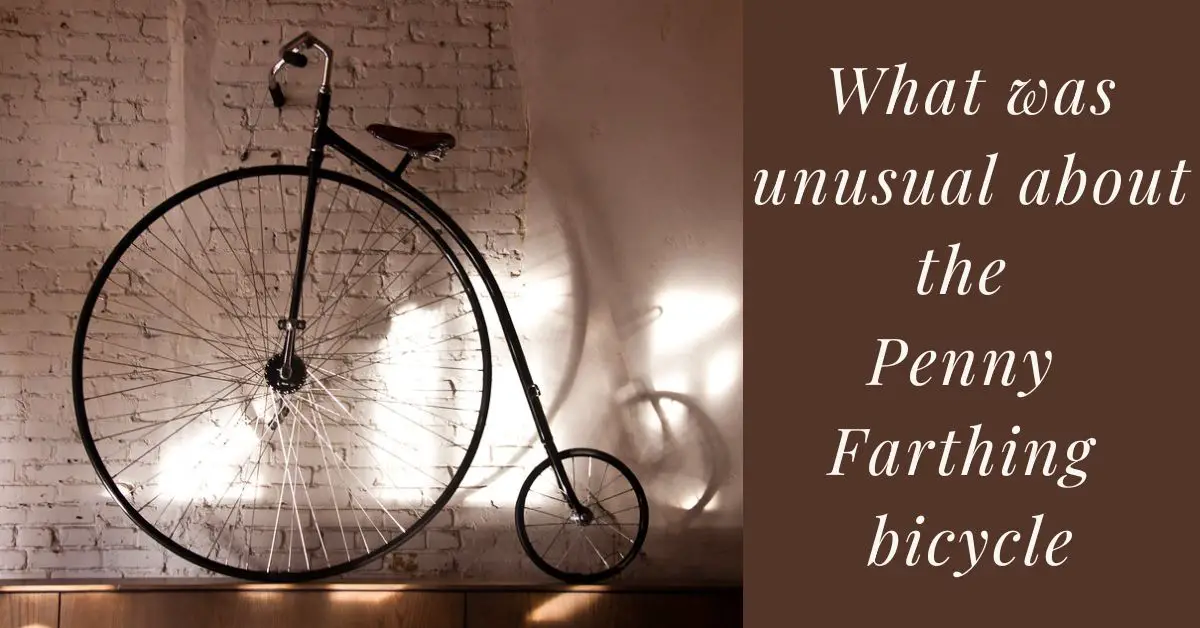What was unusual about the penny-farthing bicycle
The penny farthing bicycle, also known as a high wheel, high wheeler or ordinary, was an early type of bicycle that was popular in the 1870s and 1880s. It had a very large front wheel and a much smaller rear wheel, which gave it a distinctive appearance and some advantages and disadvantages over other bicycles of its time. In this post, we will explore what was unusual about the penny farthing bicycle, how it was invented, used and replaced by modern bicycles.
The Design of the Penny Farthing Bicycle

The penny farthing bicycle got its name from the British penny and farthing coins, which were different in size, just like the wheels of the bicycle. The front wheel could be up to 5 feet (152 cm) in diameter, while the rear wheel was only about 16 inches (41 cm). The rider sat on a seat above the front wheel, which was directly connected to a set of pedals. The rear wheel was attached to the frame by a curved metal bar. There was no chain, gears or brakes on this bicycle.
The large front wheel of the bicycle penny farthing had some advantages over the older bicycles, such as the boneshaker, which had wooden wheels with iron tires. The large wheel could travel a long distance with each rotation of the pedals, which made it faster and more efficient. It also provided more shock absorption and stability on rough surfaces, such as cobblestones or dirt roads. The penny farthing bike could reach speeds up to 40 kilometers per hour, which was impressive for its time.
However, the design of the bicycle penny farthing also had some disadvantages and dangers. It was difficult to mount and dismount, especially for women who wore long skirts.
The rider had to take a running start and jump onto the seat, or use a mounting step that was attached to the frame. To get off, the rider had to slow down and jump off or lean back and slide off the seat. The high position of the seat also made it hard to balance and steer the bicycle. The rider had to lean forward and grip the handlebars tightly, which could cause fatigue and discomfort.
The most serious drawback of the bicycle penny farthing was its tendency to tip over or throw off the rider in case of an obstacle or sudden stop. This could result in serious injuries or even death. The rider’s head was about 10 feet (3 meters) above the ground, which meant a long and hard fall. The phenomenon of falling headfirst over the handlebars was called “taking a header” or “coming a cropper”. Many riders wore helmets made of leather or metal to protect themselves from head injuries.
Read more from Bicycle Ninjaa: is triumph making a dirt bike
The History of the Penny Farthing Bicycle

The penny farthing bicycle was invented in France by Eugène Meyer in 1869. He patented a wire-spoke tension wheel with individually adjustable spokes, which allowed him to make large and strong wheels. In addition he used solid rubber tires, which were more durable and comfortable than iron tires. He produced a classic high bicycle design that became popular in England and France.
The popularity of the penny farthing bike in England was largely due to James Starley, who is considered the father of the bicycle industry. He improved Meyer’s design by adding tangent spokes, which were more rigid and stable than radial spokes. Also he added a mounting step and a hollow metal frame, which reduced the weight and increased the speed of the bicycle. He named his model “Ariel”, which became one of the most famous brands of penny-farthing bicycles.
The penny-farthing bike, a symbol of the Victorian era, heralded the birth of cycling as a sport and hobby. Wealthy men organized clubs and races, while women faced criticism and challenges due to clothing and safety concerns.
Safety bicycles and pneumatic tires made penny-farthings obsolete in the late 1880s.
The safety bicycle was invented by John Kemp Starley in 1885. It had two equal-sized wheels with a chain-driven gear train that allowed variable speed and easier pedaling. It also had a lower seat position and brakes that made it safer and more comfortable to ride. The pneumatic tire was invented by John Dunlop in 1888. It was a soft rubber tube filled with air that provided more cushioning and traction than solid rubber tires. It also made the ride smoother and quieter.
Safety bicycles and pneumatic tires revolutionized cycling, making it more accessible and popular. They were marketed as “safety bicycles” because they reduced the risk of falling and injury compared to penny farthings. They also provided similar or better speed and performance than penny farthings. By 1890, it was almost completely replaced by the safety bicycle, which became the basis for modern bicycles.
The Legacy of the Penny-Farthing Bicycle

The penny-farthing bike may have been a short-lived trend, but it left a lasting impact on the history and culture of cycling. It was the first machine to be called a “bicycle”, and it was the first to enable high speeds and long distances on two wheels. Also inspired many people to take up cycling as a sport, a hobby, a mode of transport, or a way of life.
It is still admired and appreciated by many cycling enthusiasts and collectors today. Some people restore or recreate original models of penny farthings, while others make new designs that are based on or inspired by penny farthings. People usually ride penny-farthings for fun, for exercise, for competition, or for historical reenactment. Some people display penny-farthings as decorative pieces or store decorations.
The penny-farthing bike, a Victorian icon, symbolizes nostalgia, innovation, and adventure. It has been featured in many books, movies, TV shows, cartoons, comics, games, art, and music. It has also been used as a logo, a mascot, a trademark, or a metaphor for various organizations, products, services, or concepts.
The penny-farthing bicycles, an unusual and remarkable invention, revolutionized cycling. It was a product of its time, but also ahead of its time. A challenge, but also a joy. A risk, but also a reward. It was a penny-farthing bicycle.
Conclusion
In this post, we have explored what was unusual about this bicycle, how it was invented and why it is still popular today. We explored how people enjoy penny-farthings in the modern world. Check out these web search results for penny-farthing bicycles. Here are some of the websites that offer penny-farthing bikes for sale:
- Rideable Bicycle Replicas: This website offers custom-built hiwheel bicycles, also known as penny-farthings. You can choose from a variety of models, sizes, colors, and accessories. They also sell antique replica bikes, original antique bikes, brass cannon replicas, and more.
- eBay: This website is a popular online marketplace where you can find penny-farthing bicycle for sale. You can browse through different listings of new and used penny-farthings, as well as related items such as pins, posters, lamps, and more.
- Penny farthing For sale in UK: This website is a classified site where you can find used penny farthing bicycles for sale in the UK. You can see the photos, prices, and descriptions of the bikes, and contact the sellers directly.
- Penny Farthing Dan: This website is run by Dan Bolwell, a craftsman who makes high-quality penny-farthing bicycles by hand. He designs and fits the bikes to each customer’s specifications and delivers them worldwide. He also offers repair and restoration services for old penny-farthings.
- Penny Farthing Cycles: This website is a bike shop in Dublin city centre that sells a wide range of bicycles, including penny-farthings. They also offer bike servicing, repairs, accessories, and clothing.
I hope you find this information helpful and interesting.







